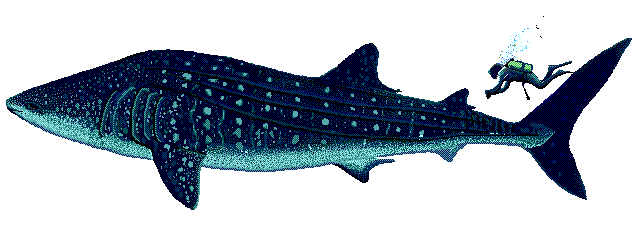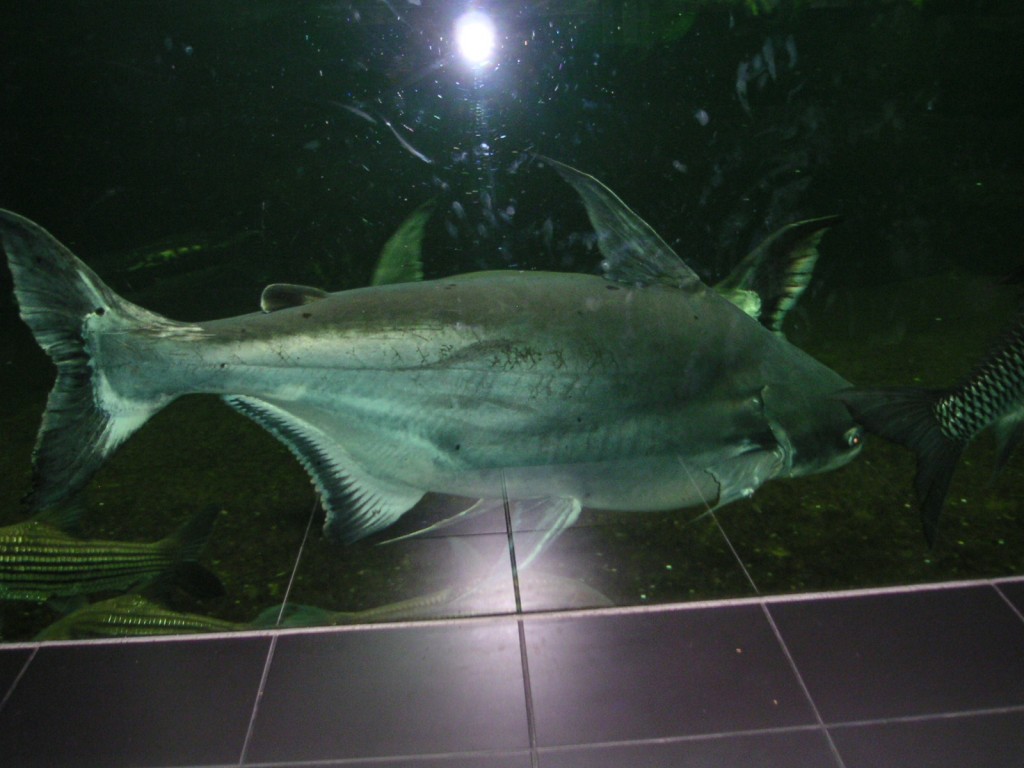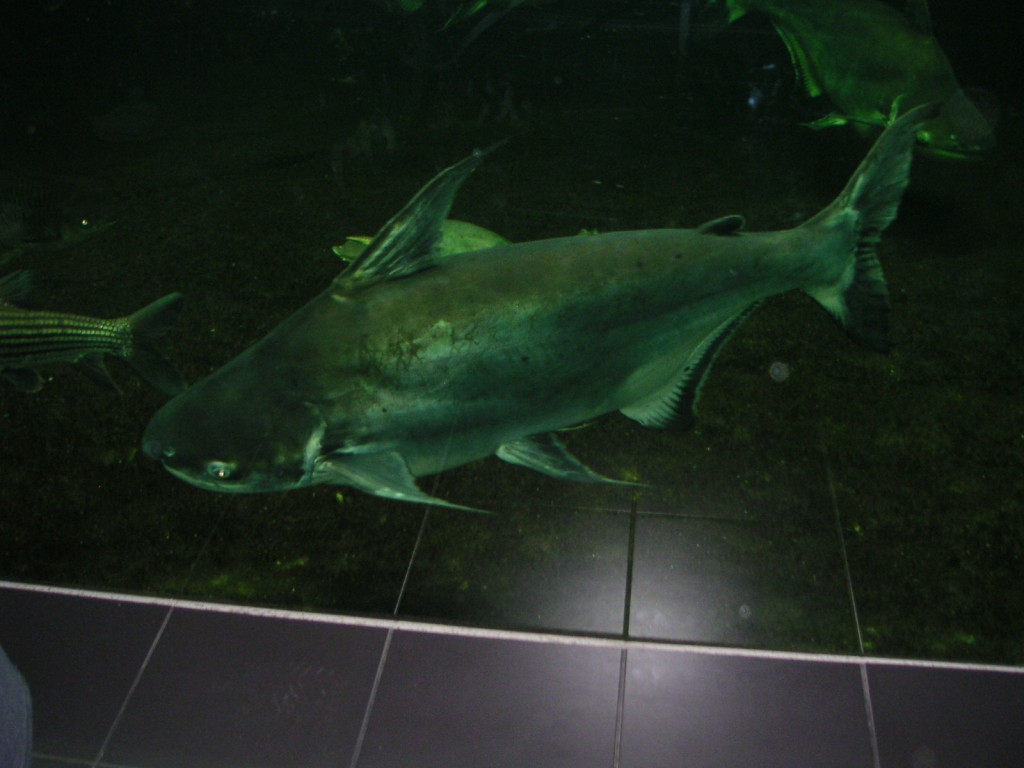
September 25, 2009
A special guest blog from Germany by Markus Felix Bühler, the coauthor of a new cryptofiction book, Der Herr der Tiefe: KryptoFiction:
The giant man-eating reservoir catfish – an example case of an internet monster hoax
The internet is really a great thing, it enables people from nearly everywhere to communicate and to get and share information. But there are also problems with this, because it makes it also possible to circulate faked stories and hoaxes very easily. Every year countless weird stories pop up, often circulating via e-mail. This includes also several stories with a cryptozoology-related background, so I wanted to write about such a case.
In 2007 this circulating Chinese e-mail emerged in the net (here translated):
Each year, a few people will be drowned mysteriously in Huadu’s Furong Reservoir. It was not until recently when the brother of a certain official went swimming in the reservoir with his friend and were drowned that the secret was unravelled!
It’s a 3 metre long man-eating catfish whose head alone is 1 metre wide! After cutting up the catfish people were surprised to find the remains of a man inside!
Because this was a huge incident, and the local government was afraid of the impact on local tourism, they imposed an embargo on the news, but people came away with these pictures taken on their cell phones of the man-eating fish!
Swimming in the reservoir is now forbidden because it is feared another similar man-eating catfish is still lurking in the waters.
Later a similar e-mail emerged completely in english (associated with the above photo):
Subject: It’s Just a Catfish!
For all those crazy guys who go ‘noodling’ for catfish and stick their arms down the fish’s throat!! This would be ‘all the catfish you can eat.’
Each year, a few people were drowning or disappearing mysteriously in Huadu’s Furong Reservoir. It was not until recently, when the son of a government official went swimming, in the reservoir and was drowned, that the secret was revealed.
It is a 3 meter long man-eating catfish whose head alone is 1 meter wide! After cutting up the catfish, people were surprised to find the remains of another man inside!
Swimming in the reservoir is now forbidden because it is feared another similar man-eating catfish is still lurking in the waters.
The photos attached to the e-mail showed a truly huge and massive fish lying on a concrete floor, surounded by several dozen people. Some of the photos show how the giant fish, now lying on its back, is partly skinned and gutted.
Reading the alleged story alone should already spark some critism in one´s mind. But looking at the photos should make it clear, that this is no catfish at all, but a whale shark (Rhyncodon typus). The shape of the body, the structure of the fins, the multiple gill slits, the colouration and the typical ridges on the back should leave no doubt. You can even see the giant liver of the shark lying on the ground, which was interpreted by some to be human remains. Sharks posses huge oily livers as they don´t have air bladders, but they don´t have much similarity in shape and colour to mammal livers, and are often the first you see when you open their body cavity.


Admittedly I have to say that the whale shark with its wide and flat head actually has a vague resemblance to some catfish species, especially to those of the genus Pangasianodon and Pangasius. One of the most famous members of this species is Pangasianodon gigas, the giant Mekong catfish, which is one of the largest freshwater fishes of the world. I has a comparably flat but wide head and small eyes, and their overall body shape is a bit similar to a those of a typical shark, for this reason they are sometimes called shark-catfish or even freshwater sharks.
Furthermore they lack the big barbels which are typical for most catfish, and posses only – similarly to the whale shark – two very small stumpy barbels in the region of the nostrils. The comparably similar body shapes are probably a product of convergent evolution. Whale sharks feed on plancton, as well as Pangasianodon-catfish, which are plantivorous in their youth and later also feed on plants and small animals.
A close relative to the giant mekong catfish, Pangasius sanitwongsei is comparably often present in zoo aquariums. This species can also reach huge sizes for a freshwater fish, and possibly even rivals its cousin Pangasianodon gigas. I had the chance to see some of the Pangasius santiwongsei catfish at the Berlin Aquarium and to make some photos.

The specimen in the photo is about 1,5 m in length, and was the largest of its kind in the tank. You can see the resemblance to the whale shark, but also the differences like the gill slits, the shape and position of the spiny fins, the lacking ridges on the back, the colouration and so on. It is surprising that some people still believe this is a catfish and the whole dumb story is true, even after being told that the fish is a whale shark and the story a hoax.
Of course this whale shark was also neither caught in a freshwater reservoir at Huadu or any other reservoir, nor had it any human remains in the stomach. The whole story is nothing more than a hoax. It has become very popular to take photos of unusual or big animals and add an invented story, like those of the camel spider in Iraq or the alleged crocodile at New Orleans.
Some people wondered why a whale shark, which is an endangered species, would be killed by humans. Sadly whale sharks and many other endangered animals are still hunted for consumption in many regions of Asia, and rare sharks are not excluded from this. Especially the fins of whale sharks are highly valuable, because rich “gourmets” vast sums of money to eat such an exclusive dish like whale shark fin soup. This specimen on the photos was still a very small one, but surely still a big catch for the fishermen.
To make a final remark about this story, I want to give a bit of advice to the readers. I am sure really most if not all of you had identified this fish a whale shark anyway, but it should also be a lesson that a lot of hoaxes and faked stories are circulating in the net. You am always a bit critical, especially when the source of the stories are obscure e-mails.
Sadly even a lot of tabloids make such stuff public. It makes also some sense to read all the comments when you read such a story at a blog or similar location. In many cases somebody has already written the true explanation. If you are not completely sure about the identity of an animal, please take the time and do a bit research for yourself, even if you think you already know it.
The internet enables you to find countless photos within a very short time, you just have to take this time. So take the time, look for photos of the animal you think it could be, but take also the time to compare it with those animals other people have proposed. But don´t just look at overall similarties, look for specific details and typical traits.
To donate to the International Cryptozoology Museum, please, click on the following museum button:
About Loren Coleman
Loren Coleman is one of the world’s leading cryptozoologists, some say “the” leading living cryptozoologist. Certainly, he is acknowledged as the current living American researcher and writer who has most popularized cryptozoology in the late 20th and early 21st centuries.
Starting his fieldwork and investigations in 1960, after traveling and trekking extensively in pursuit of cryptozoological mysteries, Coleman began writing to share his experiences in 1969. An honorary member of Ivan T. Sanderson’s Society for the Investigation of the Unexplained in the 1970s, Coleman has been bestowed with similar honorary memberships of the North Idaho College Cryptozoology Club in 1983, and in subsequent years, that of the British Columbia Scientific Cryptozoology Club, CryptoSafari International, and other international organizations. He was also a Life Member and Benefactor of the International Society of Cryptozoology (now-defunct).
Loren Coleman’s daily blog, as a member of the Cryptomundo Team, served as an ongoing avenue of communication for the ever-growing body of cryptozoo news from 2005 through 2013. He returned as an infrequent contributor beginning Halloween week of 2015.
Coleman is the founder in 2003, and current director of the International Cryptozoology Museum in Portland, Maine.
Filed under Cryptomundo Exclusive, Cryptotourism, CryptoZoo News, Eyewitness Accounts, Folklore, Guest Blog, Hoaxes, Megafauna, Photos, Pop Culture